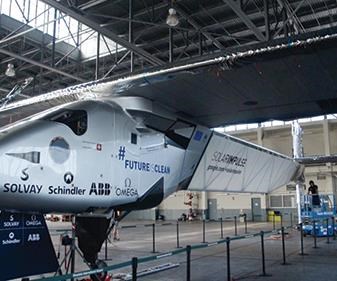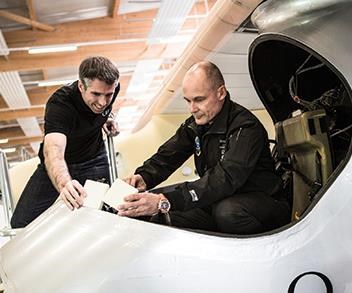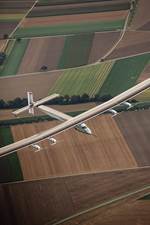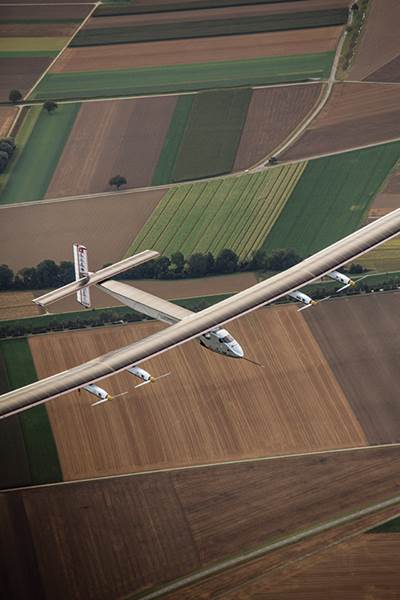Solar Impulse 2: Pulse on the future
Not yet through their ‘round the world flight, this superlight solar plane’s airframe-proven materials are already destined for higher callings.
For anyone fascinated by aircraft, solar power and/or composites, Solar Impulse is a familiar name. It identifies the Lausanne, Switzerland-based company that, in 2010, launched the self-named Solar Impulse 1, the world’s first piloted aircraft to fly all night on solar power alone. At this writing, its successor, Solar Impulse 2 (Si2), is at the halfway point of the first attempted solar-powered around-the-world flight, with Solar Impulse founder and chairman Bertrand Piccard alternating at its controls with CEO André Borschberg.
On March 9, 2015, Si2 took off from Abu Dhabi in the United Arab Emirates, and, in eight legs, flew to Muscat, Omar, thence across India — stopping at Ahmedabad and Varanassi — on to Mandalay, Myanmar, then to Chongqing and Nanjing, China, and Nagoya, Japan. From Nagoya, Andre Borschberg piloted Si2 nonstop for almost five days — 117 hours and 52 minutes — on solar power alone, arriving at Honolulu, Hawaii on July 3 at 5:55 a.m. local time. (The average air speed of the Si2 is 25 knots, or about 47 kph.)
Difficulties with the plane’s batteries (not its composites) forced Si2 to pause in Hawaii (read about the Si2’s battery difficulties online in “Solar Impulse 2 grounded in Hawaii until 2016” located under "Editor's Picks"on the top right). While the Solar Impulse team awaited resolution of this issue, CW took the opportunity to inquire into the performance and future implications of the Si2’s ultralight composite airframe, which could not have been built for its purpose with other materials (no metal could be as light, stiff and strong as needed) and without which, the aircraft’s story could not have been written at all.
Halfway around the world on thin air(frame)
For this sun-powered bird, the essential prerequisite was an extremely light aerostructure. The raw material that ultimately satisfied this need proved to be very thin composite tapes. The airframe’s main and rear wing spars, fuselage and empennage were constructed from thin-ply epoxy prepregs produced by North Thin Ply Technology (NTPT, Penthalaz, Switzerland). The ultra-thin composite tapes, known commercially today as thin-ply or spread-tow tapes, are made by spreading individual carbon fiber tows, separating the fibers and flattening them into a wider and thinner unidirectional form. For the Si2, NTPT spread M46J 12K ultra high-modulus PAN carbon tow from Toray Industries Inc. (Tokyo, Japan) to yield very thin 25-g/m2 and 100-g/m2 unidirectional tape. The UD tapes were resin-impregnated during the process and then converted into ±45° preforms up to 27m long by 1.2m wide, using NTPT’s automated tape laying (ATL) machine (for background on spread-tow technology, read more online about NTPT’s thin-ply tape technology in “Spread-tow technology takes off" located under "Editor's Picks" on the top right).
Joe Summers, NTPT sales and marketing director, characterizes this project as a big success for all parties involved. “The successful flight of Si2 validates the choice of products. Thin- ply materials have created a strong, lightweight structure capable of circumnavigating the globe with only solar power,” he says. He adds that the project further refined NTPT’s capability to manufacture, handle and transport large preforms.
All the preforms for construction of Si2 were shipped to composites manufacturing specialists Decision SA — a member, with Multiplast SAS (Vannes, France), of Groupe Carboman SA, in Ecublens, Switzerland.
When NTPT’s prepreg preforms arrived at Decision’s facility in Ecublens, they were layed up by hand into custom, precision molds designed and built by Decision for the fuselage, wing sections and tail, including tooling for the complex 27m-long wing spar box. The total length of the wingspan, including the spar box, is 72m. (By comparison, Boeing’s 787 Dreamliner has a wingspan of 60m.) The preforms and ply schedule for all airframe parts were calculated to build up the necessary fiber architecture for handling anticipated loads on the strong and lightweight plane, including spar box torque resistance and bending stiffness specifications.
Decision general manager Bertrand Cardis points out that in terms of the composite airframe structure, including the wing spar box, “We have had no technical issues with the plane. After the half-around the world flight of Si2, including spending five days over the Pacific, the behavior of everything we built has been perfect.” Cardis stresses that everything was heavily tested to the ultimate flying load on the ground before flight approval, and the flight has proceeded according to plan, verifying the approach to the composite materials and manufacturing process.
Critical cockpit construction
Covestro LLC (formerly Bayer MaterialScience, Leverkusen, Germany) designed and calculated the fairing, or outer shell and pilot access door of the Si2 cockpit. “The most important thing was to get as lightweight as possible,” explains Bernd Rothe, Covestro’s plant manager and former Solar Impulse project manager. But that critical concern had to be balanced with the need for protection against thermal dynamics and atmospheric wind currents. Ultimately, the team elected not to use a composite. The shell and door were built to Covestro’s specifications by a local prototype manufacturer, using Covestro’s then most recently developed low-density 27.5 kg/m3 rigid polyurethane foam. The 30-mm thick foam has a reduced cell cross section of 180 μm, about 40% less than the standard 300-μm cell. The cockpit windshield and windows are Covestro’s transparent polycarbonate — 1.2 g/cm3 compared to glass at 2.6 g/cm3. Covestro supplied a different, 28-kg/m3 lightweight, rigid insulating foam to protect the pilot and instruments from external temperatures that could fall to –50°C. Borschberg reports the insulation worked very well. “We were able to keep the planned temperatures in the cockpit.”
The most critical proof of part for the Si2 cockpit was to be able to eject the door under a high wind, for pilot safety, allowing the pilot to exit and bail out if the plane was at risk. For the critical door hinges, then, Covestro reinforced a specially developed polyurethane resin with a standard (but unidentified) carbon fiber, and molded them by resin transfer molding (RTM) “This was the first time we built a carbon-reinforced polyurethane part by RTM, and it worked out very well for Si2,” says Rothe.
The complete cockpit fairing, door and door hinges weathered testing in a wind tunnel, where to apply the highest probable pressure on the door, it was subject to wind speeds of 100 kph, at various angles of attack and shift, Rothe says. “Under this pressure, the pilot had no problem opening the door or ejecting the door and making a safe exit — the most important thing for us.”
Rothe expressed appreciation that “after the first two weeks, we received thanks from Bertrand Piccard and André Borschberg that everything worked well in the cockpit.” Testing in Hawaii showed the cockpit is still perfectly climate-controlled. Rothe says, “Yes, we were very proud.”
Foretelling future value
“In terms of structure, if we would do a future version of Si2 we could certainly make further improvements,” says Borschberg, “but in principle, we would keep the same concept and philosophy as it demonstrated that it works very well.”
But Borschberg emphasizes that in the long-term, the Si2’s value is in industrialization: “The objective is to capitalize on the expertise, the know-how and the network that we developed over the past 10 years in the fields of energy efficiency, ultralight material, design of complex systems, solar production and storage [energy cycle] and electric motors.”
NTPT’s Summers agrees. He imagines that the success of the Si2’s flight changes the perception of “what is possible with flight duration, power sources and construction methods. Low-power, long-duration flight is opening possibilities in such diverse applications as commercial travel, pseudo-satellites, weather prediction and military purposes.”
A promising high-performance market for the technology used for Si2 is, in fact, the so-called High Altitude Pseudo-Satellite (HAPS), or solar-powered drones, which need no launch vehicles and are sustainable and, therefore, less costly alternatives to rocket launched satellites. Borschberg says part of the Solar Impulse engineering team is already working on a concept solar-powered drone. It will be able to fly higher than Si2, into the stratosphere, which extends 50 km above Earth’s surface. A drone could be either geostationary or able to move to different locations, Borschberg explains. “It can be used for communications, measurements and observations. The team is currently focused on the predesign phase.”
Summers and Cardis both believe their thin-ply materials and manufacturing process are a perfect fit for such applications. Decision sees a rare match in terms of commercial relevance for its Si2 thin-ply composite construction experience. “We made a big jump into the future by building with this material,” Cardis says, “and we hope to apply this proven technology to solar drones.”
NTPT is pushing its thin-ply technology even further, targeting UD tapes as thin as 15 g/m2, to satisfy these and other high-performance markets. “We can already reach 15 g/m2 with Toray’s MR70, though at present, the best we have spread with M46J is 25 g/m2.”
Additionally, Summers says NTPT is constantly pushing the range of high-modulus and ultra high-modulus fibers that can be made into thin-ply prepregs. “Higher modulus thin materials are vital for very lightweight and stiffness-critical components for these types of craft.” He notes, for example, that NTPT already can manufacture thin-ply prepregs from Toray’s M55J (540 GPa) and GRANOC YSH70 (720 GPa) from Nippon Graphite Fiber Corp. (Tokyo, Japan) to weights as low as 50 g/m2.
Solar-powered drones also are being developed and promoted by Airbus, Google, Facebook and others. Google (Mountain View, CA, US) recently purchased solar-powered drone maker Titan Aerospace (Moriarty, NM, US) with the suggested goal of investigating advanced material design and other aspects of Titan’s technology for such future applications as Internet access, disaster relief and environmental damage detection and assessment.
Notably, Covestro’s Rothe reports that the composite material used for the Si2 door hinges is currently undergoing testing by major automotive companies for interior structural body parts. The goal is to produce parts with carbon fiber-reinforced polyurethanes, taking advantage of the short cycle times and high mechanical properties achieved by RTM of the hinges. Polyurethane also is being tested as a resin for wind turbine blades made by resin infusion.
On Solar Impulse 2, composites have proven their value in very light aerostructures, have given a big boost to a critical clean energy technology, and promise future value in vehicles that soar to the stratosphere as well as those that take to the streets on terra firma.
As CW went to press, rework on Si2’s battery systems had been completed and successful maintenance test flights had been conducted Feb. 26 and March 9. Solar Impulse announced April 14 that Si2 was mission ready and, indeed, the craft, piloted by Bertrand Piccard, departed Hawaii on April 21 and completed the three-day trip to the US West Coast on April 24, landing at Moffett Airfield in Mountain View, CA. For updates on its progress across the continental US to New York, then over the Atlantic to Southern Europe or Northern Africa and, finally, back to Abu Dhabi, watch CW's "News" at www.compositesworld.com/news
Related Content
Infinite Composites: Type V tanks for space, hydrogen, automotive and more
After a decade of proving its linerless, weight-saving composite tanks with NASA and more than 30 aerospace companies, this CryoSphere pioneer is scaling for growth in commercial space and sustainable transportation on Earth.
Read MorePlant tour: Albany Engineered Composites, Rochester, N.H., U.S.
Efficient, high-quality, well-controlled composites manufacturing at volume is the mantra for this 3D weaving specialist.
Read MorePEEK vs. PEKK vs. PAEK and continuous compression molding
Suppliers of thermoplastics and carbon fiber chime in regarding PEEK vs. PEKK, and now PAEK, as well as in-situ consolidation — the supply chain for thermoplastic tape composites continues to evolve.
Read MoreNovel dry tape for liquid molded composites
MTorres seeks to enable next-gen aircraft and open new markets for composites with low-cost, high-permeability tapes and versatile, high-speed production lines.
Read MoreRead Next
Spread-tow technology takes off
New, ultralight-areal-weight prepreg tapes form the thin-ply laminates will enable Solar Impulse 2’s sun-powered flight around the world.
Read MoreFrom the CW Archives: The tale of the thermoplastic cryotank
In 2006, guest columnist Bob Hartunian related the story of his efforts two decades prior, while at McDonnell Douglas, to develop a thermoplastic composite crytank for hydrogen storage. He learned a lot of lessons.
Read MoreComposites end markets: Energy (2024)
Composites are used widely in oil/gas, wind and other renewable energy applications. Despite market challenges, growth potential and innovation for composites continue.
Read More



















.jpg;maxWidth=300;quality=90)












